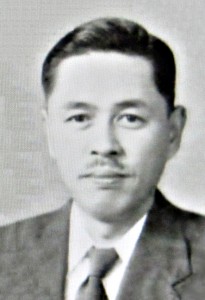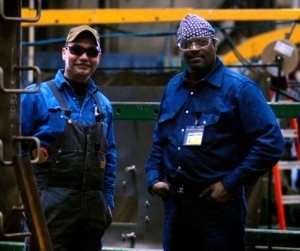 One of the famous teaching methods by Taiichi Ohno is the chalk circle. The method itself is simple. A circle is drawn on the shop floor near a point of interest. A disciple is put in the circle and told not to leave it until he is picked up again by the teacher.
One of the famous teaching methods by Taiichi Ohno is the chalk circle. The method itself is simple. A circle is drawn on the shop floor near a point of interest. A disciple is put in the circle and told not to leave it until he is picked up again by the teacher.
In this post I will explain a bit about the chalk circle, how to use it for teaching, and how to use it for yourself.
Taiichi Ohno’s Chalk Circle
Taiichi Ohno  is one of the main drivers behind the Toyota Production System, and hence by proxy, lean production. One of his famous methods was the chalk circle. On the shop floor in an area of interest (but not in the way of the workers) he drew a circle using chalk. A disciple that had a problem to solve in this area was put in the circle. The instruction given to the engineer was simple: “Watch!”
is one of the main drivers behind the Toyota Production System, and hence by proxy, lean production. One of his famous methods was the chalk circle. On the shop floor in an area of interest (but not in the way of the workers) he drew a circle using chalk. A disciple that had a problem to solve in this area was put in the circle. The instruction given to the engineer was simple: “Watch!”
And watch he did. After a while Ohno came back and asked him what he had seen. If the answer was unsatisfactory, the disciple had to watch more. Often, a disciple stood in the circle for hours before Ohno was satisfied. This exercise is also known as circle exercise or standing in the circle.
The Human Mind on the Shop Floor
 When observing the shop floor, we have a few issues. First, the capacity of the human mind to take in information is limited. If we visit a shop floor, most of us will remember only a disconnected bunch of machines, parts, and people. Only a few details can be recalled.
When observing the shop floor, we have a few issues. First, the capacity of the human mind to take in information is limited. If we visit a shop floor, most of us will remember only a disconnected bunch of machines, parts, and people. Only a few details can be recalled.
Secondly, not everything happens at the same time. Even with a perfect attention, you will only see what is happening right now. Unfortunately, a lot of events on the shop floor develop only over time. The regular processes repeat every cycle time. Failures and breakdowns, however, will be much less common.
Overall, you need to focus on a small part of the shop floor for a longer time to really understand what’s going on. Hence, it is quite tricky to really understand the actual situation. Usually, the understanding goes through different levels.
- The first level would be simply walking through the shop floor: The person knows there is a shop floor and may remember some disconnected details. By the way, this is great to hide real problems from visitors (for detail, see my post How to Misguide Your Visitor – or What Not to Pay Attention to During a Plant Visit!).
- The next level would be observing a few cycles, usually no more than 30 to 45 minutes. This is also when the average engineer or manager gets bored. The manager thinks he understands the process, but he understands only a bit and only about the regular process. He still has no idea of the problems that can happen.
- One step up would be observing an entire shift, or from 4 to 8 hours. Now the observer gets a deeper understanding of the process, including the problems. This is a good starting point for an improvement process.
- The last step is observing multiple days. Usually, this is doable only for the people who work there, although for tricky problems it may also be necessary for managers and engineers to do multiple observations.

Overall, you need a lot of detail to improve a process (see also Pay Attention to Details – Operator Training at Toyota and Scania). The chalk circle exercise is to get these details, to teach others the value of these details, and to train them into seeing these details. There is even a Japanese word for this ability to notice: Kizuki ( 気付き, Awareness, Realization).
How to Use the Chalk Circle for Teaching
The chalk circle is a good tool for teaching the value of details.
Selection of Area

The exercise should be related to a problem the trainee is trying to solve. This works best if the problem or the process is limited to a small area. Find this area, and find a spot with a good view that is not in the way of workers or logistic processes. Sometimes there is a raised walkway overhead. Overall, the spot should have a good view of the area of interest, but should not be in the way of the work. You should also inform the workers why the observation is taking place, and it helps to have a rough idea yourself of what to expect from the area.

In some cases the process of interest is mobile (i.e., a vehicle or a worker). In this case you can follow the process along. If it is a truck, you can ride with the trucker. If it is a worker, you can follow the worker. The only thing I’m still struggling with is forklifts, as they are usually only one-seaters 🙁 . Observing forklifts usually involves a lot brisk walking.
Selection of the Trainee
You should also select a suitable trainee. Who can benefit from observing the process? This is not a cheap Kung-Fu movie where the disciple follows the master’s every word. Especially in the Western world, depending on the mentality, not everybody is willing to observe a process for potentially hours on end. There is a risk of the trainee becoming upset about this “waste of time,” and mentally blocking himself from observing or using the time to fiddle with his smartphone. In this case, it can help to explain the “why” of the exercise rather than simply telling him, “Watch!”
Start of the Exercise/Observation
The trainee is placed on the spot from where he should observe. In my view, a chalk circle is not always needed. Probably not on carpet in an office. Definitely not in a clean room! In any case, the trainee is then left on his own with the instruction to watch. Oh, and tell him that bathroom breaks are okay 🙂 .
Progress Updates

After one or two hours, visit the trainee again. Ask him what he has seen and observed. Ideally, you have an idea yourself of what could have been seen. The great thing about this is that the trainee will probably have seen more than you, yet by adding a few additional comments you can make it look like you knew it all beforehand and are just checking on him. Of course, if we do the exercise together, I have seen and understood everything, I am just not telling you 😛 .
Even more important than what the trainee sees is that he learns to see. With this exercise, the trainee gets a better understanding not only of the process observed, but also – and more importantly – of how to observe!
End of the Exercise/Observation
The above update is ideally repeated until you feel the problem is thoroughly understood. It may also be ended if the shift or the trainee’s working hours end. If for any reason the problem is understood rather quickly, it may be of interest to observe a bit more just to see what happens.
If you have not yet told the trainee why you are doing this exercise, now would be a good time. Try to drive home the value of detailed observation for problem solving. If it is a lean trainee, now by the latest he should hear words like Gemba, Genchi Genbutsu, Genjitsu, etc.
How to Use the Chalk Circle for Your Own Problem Solving
The value of the chalk circle is not only for trainees. It can also help you to understand a problem in more detail. The process is similar; pick an area and observe. Expect to invest multiple hours for a true understanding.
For example, a while ago I volunteered my time for a project Lean for Refugees, where we try to improve the processes related to the refugee crisis in Germany/Europe (without any political agenda). To understand the registration of new refugees, we observed the processes in detail. I spent around half a day for an overview of the process, followed by a full day for one sub-process (others watched other sub-processes). This helped me to understand not only the normal process, but also the multitude of problems that come with it.
A Shortcut – Contextual Inquiry

We are always short on time. The chalk circle, however, is quite time consuming. Luckily, there is a shortcut. You pick the brain of a person who has already observed the process for a longer time – the worker! He has spent literally months with the process and knows a lot of the problems. You should simply ask him while observing. This way you will get a lot more information than you could ever see in a day. It even has a fancy name: contextual inquiry.
A few things are important for this contextual inquiry to work:
- It works only where workers have the time to answer your questions, e.g. if they are working on their own pace or have slack time between processes. A closely balanced line does not give the worker time to answer your questions. In any case, you must not interrupt their work.
- You still need to observe the process. Ask only whenever something is unclear.
- Everybody sees the world through their own eyes. Hence, what may be significant to the worker may not be to you, and vice versa. Take everything with a grain of salt.
- It still takes time. We are talking maybe four hours for the contextual inquiry instead of eight for the classical chalk circle. For one thing, it is to establish a relation of trust with the worker. For another, you can verify and understand what he tells you if you see it happen.
Summary
Overall, there is great value and insight in a prolonged observation. Many problems that are near impossible to solve become quite easy to understand if watched in detail. If you are into lean, you should know already the value of going to the shop floor, or Genchi Genbutsu. The chalk circle is the essence of Genchi Genbutsu.
Naturally, it works not only for shop floors but also for administrative processes, logistics, and many others. As long as you can observe it, it can help your understanding. Now go out, speed up your improvements by standing still, and organize your industry!
See also my Academic Writings
- Roser, Christoph. “Der Kreidekreis von Taiichi Ohno: Beobachten – Verstehen – Entscheiden – Handeln.” Yokoten 5, no. 2 (2016).
- Roser, Christoph. “Taiichi Ohno’s Chalk Circle in the Office.” In Proceedings of the European Lean Educators Conference. Buckingham, England, 2016.

very useful information
Dear Christoph,
Thank you for sharing in detail the process and emphasizing on the point that it is not so important for a trainee to undergo the experience of standing in a circle and observe but why it is being done and what to expect with repeated cycles of checking back and confirming what was observed or suggesting to watch more……
Ask a software developer to sit beside an user that is operating his/her software. I believe next week or next month there will be software upgrades :-D.
Aren’t there always software upgrades … 😀
Very helpfull the article! Thanks.
Fully agree. Not simple to apply these days. Thank you very much!
very good information
thanks
This article took me back to my work-study engineering days. Observing the operation and improving the process. Back then I was one individual on a floor of 120 operators and support staff
What I have learnt over the years is that our front line and support people stand in a circle at their own work area several hours every day. All we need to do is teach them the basic rules and tools of manufacturing’s 4 F’s, flow, flexibility, fast problem solving and making work more fun/enjoyable. We must then give them time to apply what they have been taught. You can see this process in operation on YouTube under Sid’ Heroes. This shows the results achieved on a two day workshop. On day one the delegates* learn and practice the techniques. On day two they go to their own work area and apply what they have learnt. On the video you will see a one piece flow cell designed, built and running in 7 hours. As always the results were amazing, Lead time before three weeks – after 48 seconds. Distance travelled. B.250 yards. – A. 15 yards. WIP. B 5000 pairs. – A. 15 pairs. Operators.. B 6. – A 5. Written guarantee of no job losses.
Well are these people called Heroes.
*Delegates are what I like to call the real experts. The people with first-hand regular practical experience of all the elements of the situation to be improved.